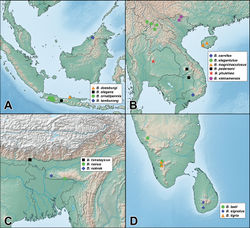Bolitogyrus carnifex
| Notice: | This page is derived from the original publication listed below, whose author(s) should always be credited. Further contributors may edit and improve the content of this page and, consequently, need to be credited as well (see page history). Any assessment of factual correctness requires a careful review of the original article as well as of subsequent contributions.
If you are uncertain whether your planned contribution is correct or not, we suggest that you use the associated discussion page instead of editing the page directly. This page should be cited as follows (rationale):
Citation formats to copy and paste
BibTeX: @article{Brunke2017ZooKeys, RIS/ Endnote: TY - JOUR Wikipedia/ Citizendium: <ref name="Brunke2017ZooKeys">{{Citation See also the citation download page at the journal. |
Ordo: Coleoptera
Familia: Staphylinidae
Genus: Bolitogyrus
Name
Bolitogyrus carnifex (Fauvel, 1878) – Wikispecies link – Pensoft Profile
- Cyrtothorax carnifex Fauvel, 1878: 166.
Type locality
‘Cambodia’
Type material
Cyrtothorax carnifex Fauvel, 1878.
Holotype (♂, BMNH): ♂, Cyrtothorax carnifex. Type., Cambodia, Mouhot [written on specimen card] / Type [circular type label with red border] / Sharp Coll, 1905-313 [printed] / Cyrtothorax carnifex Fvl. [handwritten] / Holotype ♂, Cyrtothorax carnifex Fauvel, 1878, det. A. Brunke 2017 [red printed label] / AJB0000387 [identifier label].
This specimen in the BMNH matches all information provided by Fauvel (1878)[1], who indicated that a single male was studied from Sharp’s collection in London, and is therefore interpreted as the holotype. Another BMNH specimen, here identified as B. elegantulus, and bearing no labels, was studied. According to G. Rougemont (pers. comm.), its original labels corresponded exactly to those of the type of B. carnifex. Based on the fact that Fauvel studied a single specimen from Sharp’s collection in London, and the known distribution of B. elegantulus, the true locality data for this specimen must be considered doubtful or simply, lost. However, it is possible that Mouhot did, in fact, collect this specimen during his travels (he also explored Laos) and that Sharp received it later, and prepared it in his stereotypical way.
Other material
VIETNAM: Dong Nai: Cat Tien N.P., 11.433 107.433, 6-16.VII.2012, malaise trap, leg. J. Constant and J. Bresseel, 1 ♂, AJB0000588 (IRSNB).
Diagnosis
Within the Carnifex Group: elytral disc entirely reddish (Fig. 1F); abdominal tergites III-V with relatively wide dark markings at middle (Fig. 5C); peg setae arranged in both marginal and medial groups (Fig. 11C); subapical teeth present but not on a carina (Fig. 11B); antennomeres 8-10 transverse; in parameral view, paired basal teeth appearing near margins of median lobe (Fig. 11A).
Redescription
Measurements ♂ (n = 2): HW/HL 1.39-1.40; PW/PL 1.37-1.39; EW/ EL 1.25-1.26; ESut/PL 0.83-0.84; PW/HW 1.04-1.05; forebody length 6.4-6.6 mm.
Coloration: head entirely dark; pronotum reddish with median dark, irregular spot; elytra and scutellum reddish, disc with slightly raised yellow v-shaped marking; abdominal tergites III-V reddish with central dark marking slightly more than one-third to two-thirds the tergal width, VI dark, VII-VIII dark with paler base and apex; antennomere 1 yellow, 2-5 reddish, 6-10 dark brown, 11 yellow-brown; palpi brownish orange, apical segment darkened; legs yellowish brown, dorsal surface but not lateral face of mid-femur with darker brown (Fig. 5E) (on holotype), one nontype male with slight ventral darkening, hind femur with subapical band of dark brown; outer faces of tibia paler.
Head distinctly transverse, dorsal surface with moderately dense, clearly separated asetose punctures, frons with only scattered punctures and deep Y-shaped impression. Antennomeres 8-10 slightly transverse and asymmetrical.
Pronotum distinctly transverse, about as wide as head, convex and with very few shallow micropunctures scattered on disc, becoming more distinct on anterior angles. Elytra slightly transverse, suture distinctly shorter than pronotum at middle.
Abdomen with disc of tergites III-V distinctly impunctate; sternites III-IV with basal line distinctly, V weakly projected posteriad at middle.
Median lobe in lateral view strongly constricted in apical fourth, apical fourth deflexed ventrad, apex knob-like without distinct median tooth, with weakly formed pair of subapical teeth (Fig. 11B); median lobe with pair of basal teeth, in lateral view appearing removed from expanded ventral face (Fig. 11B), in parameral view appearing at lateral margin (Fig. 11A); median lobe in parameral view weakly expanded to apical fourth, at this level forming triangular, extremely slightly acuminate apical portion, apex acute but rounded (Fig. 11A); paramere slightly constricted in basal third, weakly dilated in apical third and narrowed evenly to apex (Fig. 11C); peg setae with marginal group, median group disorganized and connected in several places to marginal group (Fig. 11C); male sternite VIII with shallow emargination and triangular glabrous area medially; male sternite IX moderately expanded at midlength, with distinct, deep emargination.
Female unknown.
Distribution
Figure 20B. Known from southern Vietnam and an unknown locality in Cambodia.
Bionomics
One specimen has been collected in July.
Comments
Bolitogyrus carnifex is probably most closely related to allopatric B. pederseni and B. vietnamensis based on the wide abdominal markings and the laterally placed basal teeth of the median lobe. It can be distinguished from these two species by the weakly formed subapical teeth of the median lobe that do not form carinae.
Taxon Treatment
- Brunke, A; 2017: A revision of the Oriental species of Bolitogyrus Chevrolat (Coleoptera, Staphylinidae, Staphylininae) ZooKeys, (664): 1-97. doi
Images
|
Other References
- ↑ Fauvel A (1878) Révision du genre Cyrtothorax. Bulletin de la Société Linnéenne de Normandie 3: 163–166.



